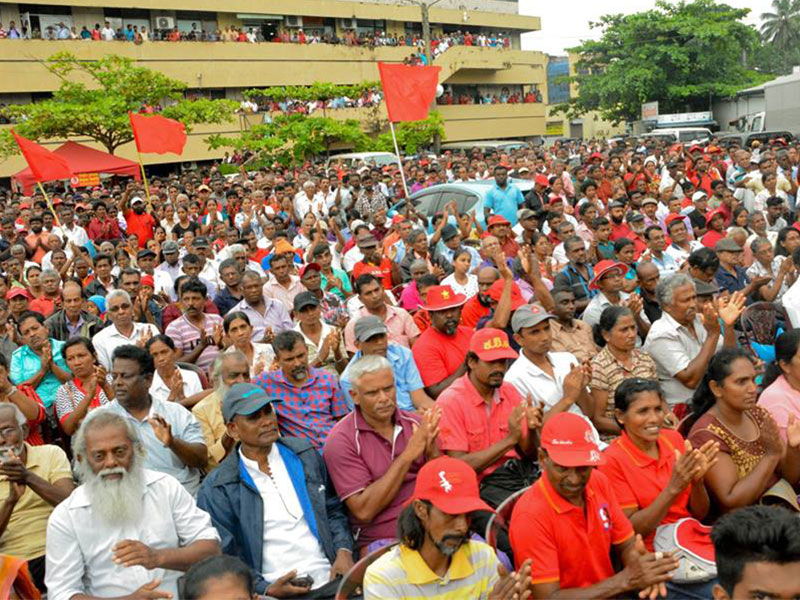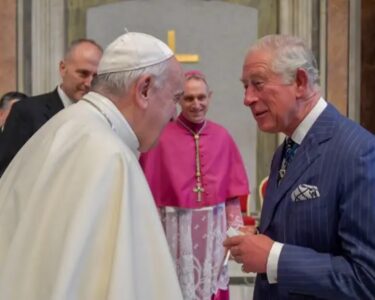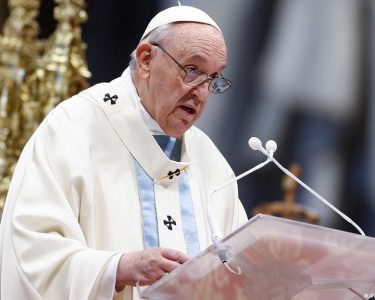Election campaign energizes Sri Lankans weary of economic turmoil
Presidential candidates tap public misgivings about IMF-directed policy changes- Reports
Marwan Mackan Macker
Asia regional correspondent Nicki Asia
MATARA, Sri Lanka — Lately, a whole day can pass at Kusum Fernando’s small pharmacy in the southern Sri Lankan coastal town of Matara without a single customer coming in.
“[This] was never the case before,” said the bespectacled 66-year-old, leaning over a glass counter. “The patients who come to buy medicines have dropped by half for every month. … Even when some patients come with prescriptions for three days, they only buy medicines for one day because they do not have money for the full dose.”
Chandrasiri Wickremeratne, who has run another Matara pharmacy for 30 years, is seeing fewer customers too. “Some patients with diabetes have stopped buying their medicines because they have no cash,” he said. “They say they might as well die.”
Many small retail businesses outside Sri Lanka’s urban hubs and tourist enclaves are feeling squeezed by depressed consumption. Most households are struggling to recover from five years of devastating economic and political turmoil that has sent the ranks of the poor soaring to 7 million from 3.04 million and kept real wage growth stagnant.
This volatile backdrop has voters, long accustomed to partisan campaigning exploiting ethnic and religious fault lines, now focusing on economic issues as they prepare to go to the polls on Sept. 21 for the first time since 2020, this time to elect a new president.

Colombo slum residents in 2023: Sri Lankan households are struggling to recover from five years of devastating economic and political turmoil. (Photo by Ken Kobayashi)
To be sure, the economic outlook is better in Colombo and other key centers due to the taming of inflation, the return of foreign tourists and the resurgent Sri Lankan rupee. Adventurous investors are seeking opportunities, with local stocks regaining most of the ground lost since 2022 when Sri Lanka became the first Asian nation to default on its debts in more than 20 years.
The Aragalaya protest movement that ousted President Gotabaya Rajapaksa shortly after the default inspired Wanni Arachige Supun, a resident of Embilipitiya, an inland southern town that is the poorest in the country. He has recently been posting YouTube videos on economic topics.
“The Aragalaya and what has happened since have changed the conversation,” said the 22-year-old.
According to Jayadeva Uyangoda, professor emeritus of political science at the University of Colombo, voters like Supun embody a broad trend.
“The absence of the previous political ideology is the new factor in this election, with economics having taken primacy,” Uyangoda said, adding that the crisis “has transformed the Sri Lankan public to become active citizens, not passive voters like before.”

Campaign posters for Anura Kumara Dissanayake of National People’s Power in Colombo on Aug. 19. (Photo by Shinya Sawai)
While the public is keen to vent its frustrations, it remains to be seen whether sentiment will congeal decisively around a particular candidate.
Frontier Research, a Colombo-based economic analysis company, suggested in a note to clients last month that this election could be the first in Sri Lanka in which the winning presidential candidate does not receive majority support.
“Since this is not something Sri Lankans are used to, the scenario of a president being elected with a mere 30-35% of the overall votes cast is then something to prepare for, as well as the questions of legitimacy and credibility that such a victory might bring up,” wrote Chayu Damsinghe and Arshad Ismail.
This will be key as the election winner will inherit the remaining two and half years of a contentious, four-year International Monetary Fund economic support program. Many Sri Lankans believe the IMF has prolonged their plight by increasing their tax burden and living costs while others credit the fund’s $3 billion program with putting the country on the road to recovery.
It is incontestable that Sri Lanka was in desperate need of rescue in 2022 when Colombo sought help from the IMF for the 17th time, more times than any other Asian country except Pakistan. With Sri Lanka’s foreign reserves almost depleted and the rupee plummeting, fuel, medicine and food were tough to find, and residents were lining up for charity meals. Inflation soared to 69.8%. Power cuts were frequent.
“Sri Lanka’s crash was impressive, because no country I know has run out of money as Sri Lanka did,” said a European emerging markets investor who holds defaulted government bonds.
Nearly half of respondents in an August 2023 government survey said they had taken a pay cut or had their working hours reduced since March 2022. Around three-quarters reported having had to change their diet due to the financial squeeze. One in seven said they had lost their main job.
Since early 2023, the IMF has guided the restructuring of the government’s finances, focusing on reining in public spending and increasing tax revenue. This has enabled the government to rebuild its reserves to $5.65 billion from a low of $1.71 billion. By August, inflation was down to 0.5%, far below the central bank’s 5% target. The rupee, which had fallen as low as 368 to the dollar, is back to 300, though still far from its 200 level as of 2021.
“The economic reform program implemented by the Sri Lankan authorities is yielding commendable outcomes,” said IMF Senior Mission Chief Peter Breuer at the end of a visit last month, noting the country had escaped recession with three straight quarters of real growth.
“The authorities have made commendable progress with putting debt on a path towards sustainability,” he said. “With Sri Lanka’s knife-edged recovery at a critical juncture, sustaining the reform momentum and ensuring timely implementation of all program commitments are critical to cement the hard-won economic progress to date and put the economy on a firm footing.”
The tourist sector exemplifies the rebound. Through Aug. 25, Sri Lanka had received 1.34 million visitors, putting it on course to approach the 2.3 million the country received in 2018. Over the first half of the year, Sri Lanka earned $1.56 billion from foreign tourists, according to central bank figures, compared to $2.19 billion in the same period six years ago.
At Mirissa, a popular beach town in southern Sri Lanka, bars and restaurants along the shore are bursting with young holidaymakers from Europe and elsewhere.
“We have been open throughout the year so far, unlike last year when we shut down after April for three months,” said restaurant manager Sameera Shrimal. “Some tourists are first-timers and some are returning after being to Mirissa last year.”

Beachfront businesses in the southern town of Mirissa are bustling with young European holidaymakers. (Photo by Shinya Sawai)
Forward bookings with hotel and tour operators suggest arrivals could hit a record high in December, according to Trisha Peries, head of research at local investment bank Capital Alliance Holdings, who said in a client note last week that the country is benefiting from political tensions that have soured Indian tourists on the Maldives.
The tourism rebound is helping revive the construction industry. In April, ITC Hotels opened a $500 million luxury hotel on a waterfront site in Colombo, creating the Indian company’s first overseas outpost; its restaurants are packed with foreign tourists and wealthy locals, particularly a sky lounge with high tea and panoramic views. Local conglomerate John Keells Holdings is developing the country’s first large casino resort nearby, the $1 billion City of Dreams Sri Lanka, in cooperation with Macao’s Melco Resorts & Entertainment.
“We expect tourism to be a strong driver for economic growth,” international research company BMI said in a July report on Sri Lanka. “Given that 25% of the population worked for the tourism sector in 2020 (latest data), growth in arrivals has resulted in higher domestic consumption from both tourism and locals thereby driving up growth.”
Macao’s Melco Resorts & Entertainment is developing the $1 billion City of Dreams Sri Lanka, which will be country’s first large casino resort, in cooperation with local conglomerate John Keells Holdings. (Photo by Shinya Sawai)
Yet misgivings about the IMF program are widespread among Sri Lankans. Grumbling is particularly intense around value-added taxes, as the base rate has climbed from 8% in 2021 to 18% this year and exemptions for necessities such as fuel, cooking gas and school supplies have been eliminated.
Under the pressure of IMF-backed austerity measures, job growth, which even in 2022 remained positive, has reversed, with total employment last year falling by 137,815 or 1.7%.
“Outside of Colombo, people have not benefited much from the macroeconomic stability,” said Thilina Panduwawala, a senior macroeconomist at Frontier Research. “There is not much thought of how the [IMF] program benefits Sri Lankan people.”

President Ranil Wickremesinghe addresses a campaign rally in Dambulla on Aug. 24: He has sought to tackle cost-of-living concerns in recent months. (Photo by Shinya Sawai)
For better or worse, President Ranil Wickremesinghe is the Sri Lankan face of the IMF program.
Parliament chose the 75-year-old as president after Gotabaya Rajapaksa fled. Wickremesinghe was not an obvious choice as he had lost his seat in the legislative election two years earlier, when his party retained just one seat.
Yet the six-time prime minister proved his worth by securing the aid of the IMF. “The president was the only one who could have done it from among those in the government’s ranks, and he has got international support,” said a Colombo-based diplomat involved in Sri Lanka’s debt restructuring talks.
In recent months, the Wickremesinghe administration has sought to tackle cost-of-living concerns by pushing through a 22.5% cut in electricity rates, raising the national minimum wage by 40% and seeking an understanding with the IMF about cutting income taxes.
In August, officials approved an increase in fertilizer subsidies for small farmers and a 24% increase in the base pay of public employees. Meanwhile, with inflation dwindling the Central Bank of Sri Lanka has been easing back on interest rates, in turn giving a lift to commercial lending.
Yet ill feelings generated by the IMF program and Wickremesinghe’s association with the Rajapaksa clan have left him running well behind the front-runners in preelection public opinion surveys on the 38 registered presidential candidates.
Among the last to file before the Aug. 15 deadline was 38-year-old Namal Rajapaksa, the eldest son of clan head Mahinda Rajapaksa, who previously served as president and prime minister.
The junior Rajapaksa, a legislator who served in the cabinet of uncle Gotabaya Rajapaksa, is the nominee of the family’s Sri Lanka Podujana Peramuna (SLPP) party, which remains by far the largest in Parliament. Few think Namal stands much chance given raw feelings about the economic collapse overseen by his uncle, but some believe his candidacy could help keep the SLPP relevant through the next parliamentary election.
Gotabaya Rajapaksa won the presidency in 2019 on a majoritarian campaign that played on tensions between the country’s Buddhist Sinhalese majority and minority Hindu Tamils and Muslims. While the Rajapaksa dynasty is credited with vanquishing the 30-year separatist insurgency of the Tamil Tigers, the brothers’ presidencies are also associated with rampant corruption, crony capitalism and political repression.
Under Gotabaya, ill-judged financial decisions, particularly huge tax cuts and widened tax exemptions, pushed the country’s indebted economy over the edge against the backdrop of vanished tourists and rocketing commodity prices due to the COVID pandemic and Ukraine war.
Gotabaya was finally driven out of the country when tens of thousands of enraged citizens besieged the streets of the capital under the banner of Aragalaya, the Sinhala word for struggle, to express their fury with the country’s economic misery and shortages of living essentials.
Protesters celebrate in the office of Ranil Wickremasinghe, then prime minister, after President Gotabaya Rajapaksa fled the country on July 13, 2022. © Reuters
“The legacy of the Aragalaya will be felt with the presidential election because it showed that people want something different and not the politics of the old guard,” said Swasthika Arulingam, a lawyer and trade union advocate who was heavily involved in the protests.
Such sentiments have lifted the fortunes of legislator Anura Kumara Dissanayake, the 55-year-old nominee of the left-leaning National People’s Power (NPP) alliance, which currently holds three of parliament’s 225 seats.
Dissanayake and his coalition have toned down previous Marxist rhetoric to focus on a campaign message of cleaning up government and corruption, positioning their past exclusion from power as a virtue. Dissanayake has argued for restoring VAT exemptions and revisiting other IMF-directed reforms to reduce burdens on the public while also seeking to curb presidential powers.
“We are tapping into the desire for change that voters want after the 2022 crisis,” said Harini Amarasuriya, a sociologist and another NPP parliamentarian. “Our campaign is about transformation against an out-of-touch old order, and the voters’ economic concerns are a key issue this time.”
Rivals Sajith Premadasa, left, and Anura Kumara Dissanayake, right, are leading opinion polls heading toward the presidential election on Sept. 21. (Photos by Shinya Sawai)
Vying with Dissanayake at the top of opinion polls is Sajith Premadasa, nominee of the center-left Samagi Jana Balawegaya (SJB) and leader of the parliamentary opposition.
The 57-year-old has drawn from the grassroots-centered political legacy of his late father, who was assassinated while president, in seeking to tap into economic discontent by making pledges to improve social welfare, lower the VAT and soften the edges of IMF-linked austerity measures while also promising action on corruption and presidential authority.
The election, said SJB parliamentarian and economist Harsha de Silva, will center on “who has the ability to grasp this economic problem, like the unprecedented poverty numbers, and to help families to get to a better place.”
With no major candidate seeking to tear up the loan agreements with the IMF, fund-directed reforms seem likely to remain largely intact whoever wins.
“Given the economic balance and geopolitical interests in Sri Lanka, any political party that comes to power in the upcoming election does not have room to deviate significantly from the reform path the country has taken,” wrote Ruchir Desai, co-manager of the Hong Kong-based AFC Asia Frontier Fund, in a recent client note.
Added Desai, whose fund is an investor in John Keells and rival conglomerate Sunshine Holdings, “Any major deviation from the reform path will be extremely detrimental, not only to Sri Lanka’s IMF program, but also to the country’s economic and geopolitical prospects.”
Applicants line up outside a passport office in a Colombo suburb on Aug. 21: Many Sri Lankans are looking to take their chances elsewhere. (Photo by Shinya Sawai)
Still, the prospect of more difficult years ahead has many Sri Lankans looking to take their chances elsewhere. Around 300,000 islanders left the country in both 2022 and 2023 to seek work overseas. Long lines remain outside passport offices. The outflow has included senior managers and professionals, including doctors.
Lenaduwa Dilshan, a 28-year-old hotel waiter in the southern town of Galle, is looking for a better-paying job in Japan. “I need to earn money to pay for my mother’s health bills,” he said. “She is a heart patient.”
Meanwhile, back in Matara, a retired school principal suggests Sri Lankans remain angry enough to take to the streets again.
“We are sitting on an economic volcano,” he said. “We don’t know when it will erupt







